Imagine a smoky Italian jazz club. A young man in a dark suit leans over a microphone, completely absorbed by a ballad’s lyrics, even as his delivery — a soft, inflectionless tenor — belies the emotion roiling beneath the surface. It’s a classic, “My Funny Valentine,” sung in the inimitable Chet Baker style. But it’s not Baker; it’s Matt Damon, depicting the sociopathic con-artist Tom Ripley in Anthony Minghella’s film, The Talented Mr. Ripley. Damon’s Ripley consciously copies Baker in what the film script refers to as “a flawless imitation.” This is one of several references to Baker in Minghella’s adaptation of Patricia Highsmith’s novel, most notable for its release date — 1999. 11 years after Baker’s fall from an Amsterdam hotel window, Minghella selected the jazz musician as shorthand for cool sophistication and as the leitmotif for Ripley’s improvisatory shapeshifting.
Baker has long fascinated the public. He became an icon in the 1950s, with the help of bandleader Gerry Mulligan and photographer William Claxton; a junkie ex-con in the 1960s; a has-been in the 1970s; and, finally, a comeback story in the decade leading up to his death in 1988. With an arc like that, it’s no wonder so many have been drawn to him. Fashion photographer Bruce Weber highlighted Baker’s late period (erroneously, according to some) in Let’s Get Lost, a 1988 documentary. Baker’s likeness, along with Gerry Mulligan’s, appears in the background during a party scene in Curtis Hanson’s film L.A. Confidential. Jazz-musician-turned-detective-novelist Bill Moody even centered his third Evan Horne book, 2002’s Looking for Chet Baker, on “solving” the trumpeter’s mysterious death (more on this later). Most recently, in 2015, Robert Budreau wrote and directed Born to Be Blue, starring Ethan Hawke as mid-period Baker. The past two decades have also seen the publication of multiple biographies as well as Baker’s fragmentary memoir, As Though I Had Wings. Not bad for a man who Miles Davis described as “worse than me even when I was a terrible junkie.”
•
Like many others, my interest in Baker began outside the scope of his music as well. On a trip to Seattle in high school, I bought a collection of William Claxton reproductions from a store near Pike Place Market. The images reinforced, and helped shape, the stylish, romanticized view of mid-century jazz I’d imbibed from album covers and liner notes. They depicted Miles Davis with twin totems — trumpet and cigarette —, Donald Byrd blowing notes on a subway car, and Max Roach leaning over his drums, sticks raised in a V. Most of all, I was captivated by the multiple images of a young, unknown-to-me, Chet Baker, who graced the cover of the book, lying on his back, horn on his chest, mouthpiece resting against his lower lip. Baker was young in all four of the photographs, hair slicked or more often tousled, wearing the fashions of 1950s southern California. He was the epitome of West Coast Cool.

For this reason, I couldn’t believe my eyes when, a few years later, I received another black-and-white jazz postcard of Baker. This time, he was in his 50s, face sunken in from what I would later learn was decades of drug abuse and dissipation. The brim of a fedora covers his forehead, seemingly propped up by the deep furrows in his brow. He is unshaven, with eyes that look so kind I imagine the photographer capturing him right before his lips turned up into a grin.
The years between my encounters with these photographs had led me down a rabbit hole of Baker’s music, beginning with his work with Gerry Mulligan and on through his long solo career. Without meaning to, however, I’d managed not to actually see late-life Baker until I removed that postcard from my mailbox. Studying it, I had no idea what had brought about such changes. I could not believe this was the same man I’d been captivated by for his hip demeanor and mellow tone. A deep dive into his life brought an enhanced appreciation for his artistry and a better grasp of the pitfalls lying in wait throughout Baker’s life.
•
Baker’s initial appearance on the music scene is the stuff of legend. In 1951, alto saxophone titan Charlie Parker was on the bandstand auditioning trumpet players at the Tiffany Club in Los Angeles. A “who’s who” of West Coast trumpeters was in attendance, but Parker asked for Baker by name. The 22-year-old took the stand for two up-tempo tunes, at which point Parker dismissed the others and hired the young man for his tour. Though he could be prickly with his sidemen, even with fellow great Dizzy Gillespie, when Parker returned to the East Coast, he told Gillespie and Miles Davis, “There’s a little white cat out in California who’s going to eat you up.” This was just the beginning.
The following spring, Baker joined baritone saxophonist Gerry Mulligan’s soon-to-be-famous “pianoless quartet.” The group took the West Coast by storm. Mulligan, a veteran of Miles Davis’s groundbreaking Birth of the Cool sessions, brought added sophistication and heft to the breezy West Coast sound. While the group lasted only a brief time, its importance, especially for Baker, cannot be overstated. According to noted jazz writer Ted Gioia, “No later work by Baker would achieve the degree of renown earned by his early collaboration with Mulligan. This is unfortunate. Baker’s best work as a soloist was still in the future at the time of the pianoless quartet.” Baker’s solo career would span most of the next 40 years, but for casual listeners, he’ll forever be associated with the West Coast’s cool school of jazz.
This blind spot leaves a great deal of wonderful music unexplored. Whether strictly instrumental or a mix of trumpet and vocals, Baker would go on to produce many essential albums over the years. A prolific (perhaps too prolific) recording artist, even at the depths of his heroin use, Baker went into the studio regularly. Including his work with Parker and Mulligan, biographer Jeroen de Valk’s extensive discography lists Baker’s output at 261 records, some of them compilations of multiple original albums owing to the expanded length of compact discs and digital formats.
Gioia sums up Baker’s playing and singing quite well in the book West Coast Jazz:
He played very softly and was one of the few trumpeters who required amplification even in an intimate setting. His singing was softer still, often lingering just above a whisper. His technique and range were modest, especially in later years, but he did so much with his limited musical tools that one scarcely kept track of what he couldn’t or didn’t do.
Unlike the pyrotechnics of players such as Dizzy Gillespie and Freddie Hubbard, or the constant reinventions of the man he’s most often compared to, Miles Davis, Baker remained steadfast in his restrained lyricism. Still, he found endless ways to approach his music, even in later years when he tended to stick to a limited repertoire. A middle-register player, he explored a seemingly endless array of options within that range; known mostly as a balladeer, he could still play up-tempo with the best of them, as is evident on an album such as Chet is Back.
If one tune were to represent Baker’s career, it would certainly be “My Funny Valentine.” Written by Richard Rogers and Lorenz Hart in 1937, it grew to be an unofficial Baker theme song. In fact, Baker and Mulligan recorded an instrumental version in 1952, a year before Frank Sinatra made it famous on his album Songs for Young Lovers. Two years later, Baker recorded the vocals for the first time, and the die was cast. According to Will Friedwald’s Stardust Melodies: A Biography of Twelve of America’s Most Popular Songs, “At least a hundred recordings of ‘Valentine’ are listed in Chet Baker’s discography, mostly private tapes of live gigs from Europe in the seventies and eighties.” It was even the final song recorded for his The Last Great Concert, not long before his death. Friedwald describes Baker as “play[ing] it painstakingly slowly and deliberately, almost as if he were plucking out nerve endings. He sings it earnestly, not with a lot of vocal technique but heavy with heartfelt charm.” Such an assessment fits the vast majority of Baker’s vocal performances. Morris B. Holbrook concurs, writing, “He had a flair for seeming constantly on the brink of losing his place or hitting a clinker, but somehow — magically — always managing to come up with the perfect note instead.” Especially later in his career, when his singing became airier and lisping, he performed with minimal vibrato or other effects but is more captivating for such omissions.
•
Often photographed bare-chested or in a simple white t-shirt, he typified the cool, relaxed West Coast jazzman of the 1950s but soon evolved into Exhibit A for the ravages brought upon the jazz community as a result of rampant drug use. While many musicians, including legends such as Miles Davis and John Coltrane, struggled with this demon, Baker remained in heroin’s thrall for most of his adult life, and his matinee-idol looks suffered as a result. This was exacerbated by a 1966 beating, the origin of which has been debated ever since. Baker was either attacked by random strangers or by associates of a drug dealer he owed money to, depending on which story one believes. Regardless, the assault knocked out part of an already-deteriorating front tooth, an essential component in creating the embouchure necessary to play any brass instrument. Such a loss could have proved insurmountable, but Baker persevered and became as accomplished a player without his front teeth, which he would lose for good in 1968 or 1969 as a result of the beating and of drug abuse, as he had been previously.
Even his death is not without drama. Baker died on May 13, 1988, in Amsterdam; that much has been agreed upon. His body was found on the ground outside the Hotel Prins Hendrik, a location that “gave junkies a handy place to shoot the dope they had scored on Zeedijk, just steps away,” according to James Gavin’s biography. Baker had landed on the sidewalk after falling from the window of his room in the hotel. How he fell is up for debate, and often wild supposition. Theories run from suicide to an accidental fall after having passed out due to drugs to the more nefarious — murder at the hands of a drug dealer or a plot on behalf of the hotel to cover up a drug overdose. Gavin goes so far as to state, “Baker, it seemed, had died willfully of a broken heart. It was an ultimately romantic gesture on the part of someone who at times had seemed demonically inhuman.” Baker’s life and death seem to encourage such flights of fancy. No matter the cause, the result was the same. At 58, Baker was gone. At his estranged family’s insistence, his gravestone provides no acknowledgment of his life as a musician.

As I hope this makes clear, with Baker, music is only part of the story. In order to fully grasp his significance within popular culture, we must also look at the mythos surrounding him and the often less salacious truth that lies beneath that dramatic surface. It is only by looking concurrently at Baker’s music and image that we can truly understand why he has endured despite the existence of more technically-gifted trumpeters and impressive vocalists. Many such musicians came to the fore throughout his tumultuous lifetime, but few have captured the public’s attention or endured in the way that Baker has. For all of his limited range, not to mention the dramatic loss of the youthful good looks that are at the root of his image, he managed to make a living as a musician for decades and has persisted in the popular imagination and jazz fans’ collections almost 35 years after his death.
•
In my office, I’ve taken to listening to “late Baker” more than other periods. I still enjoy the polish of the Mulligan-Baker combination, but I prefer the edge that years of playing, and of life, add to his sound. Live in Tokyo, from 1987, is a personal favorite. In his extensive annotated discography, de Valk argues that it might be Baker’s best album — period. Baker plays many of his classic tunes, including a surprising number made famous by his rival, Miles Davis — “Stella by Starlight,” “Four,” and “Seven Steps to Heaven.” In a nod to Elvis Costello, with whom he collaborated twice in the 1980s, he performs “Almost Blue” in a rendition so good I have to remind myself how recent an addition it was to his repertoire. And, of course, he offers yet another version of “My Funny Valentine.” He wastes no time with extended introductions or rococo variations on the melody, instead launching into the lyric with the barest piano lead-in. His voice remains so ethereal, including the occasional scatted embellishment, that the drummer almost drowns him out with nothing more than his brushwork. When Baker picks up his horn, however, he comes through loud and clear. Some of the notes crack, but his mid-register runs and occasional high notes make up for this fault. In fact, I believe the tune is better for the near mistakes. Less polished, lacking the pristine veneer of his early work, he conveys the off-kilter meaning behind the lyrics even more expressively with his horn than he does with his voice.
Occasionally, a student will enter my office before I can turn down my music. More often than not, they’ll pause, offering the same bemused expression Baker had on his face in that late-life postcard that launched my investigation. Some of them will even ask who I’m listening to and nod, not in recognition but in a way that suggests they want to remember the name. I wasn’t much older than they are when I became hooked. For all I know, I’ve introduced a new generation to their next obsession. If they’re anything like me, they’ll be in for the long haul. •




